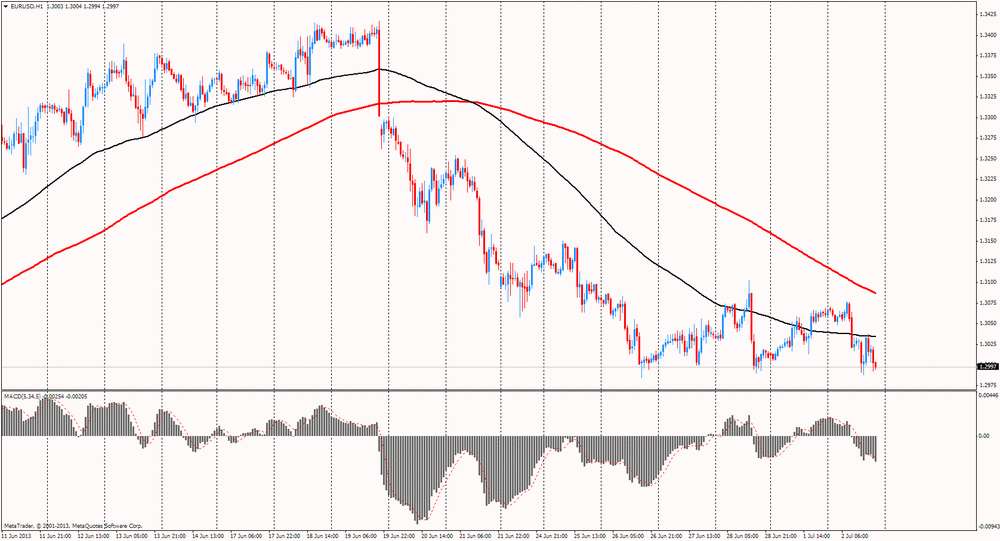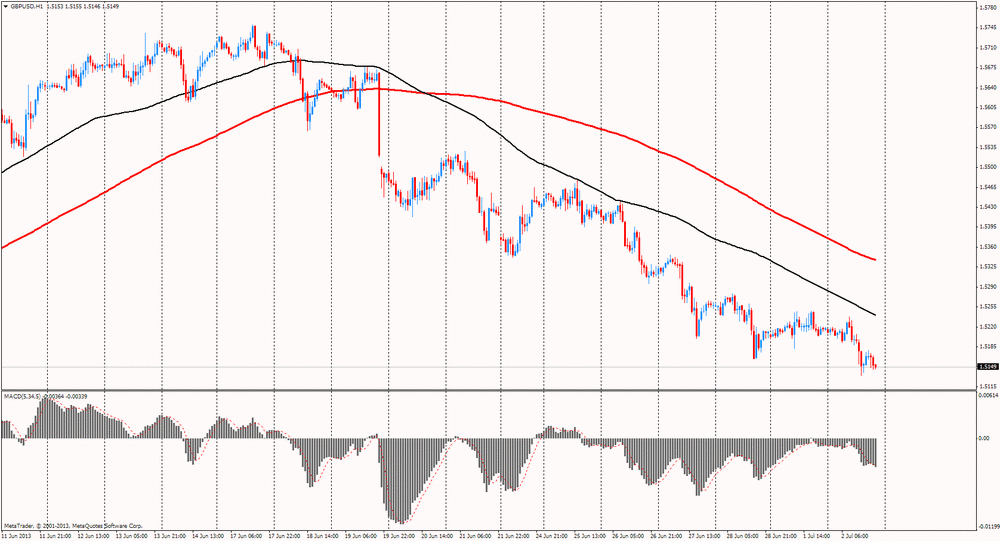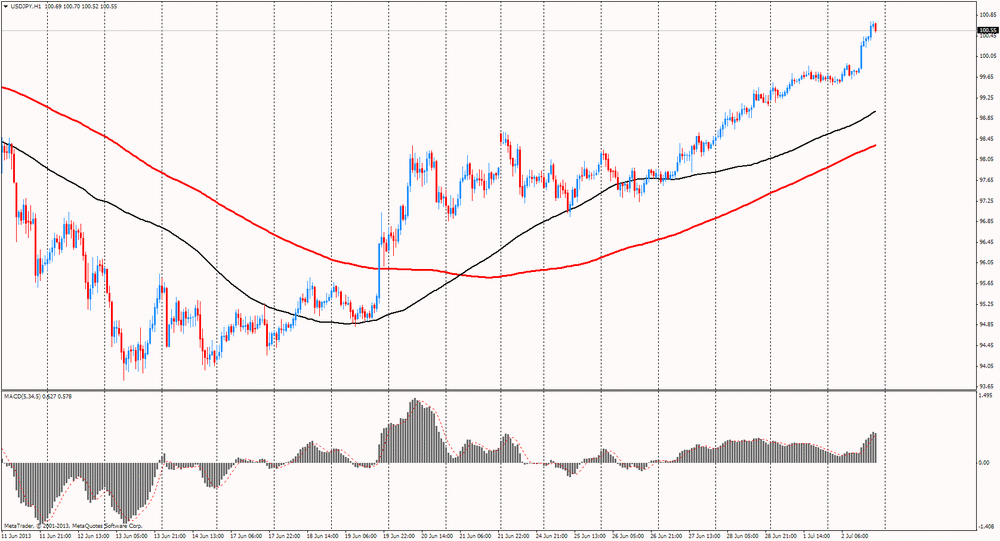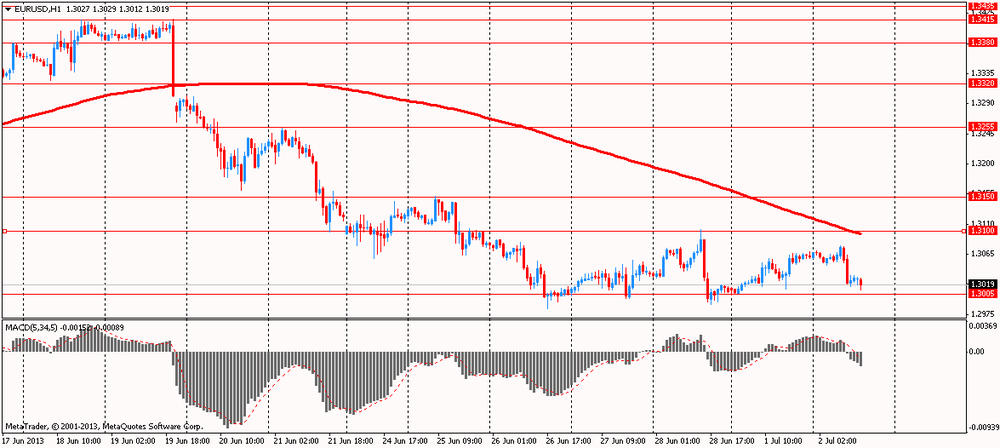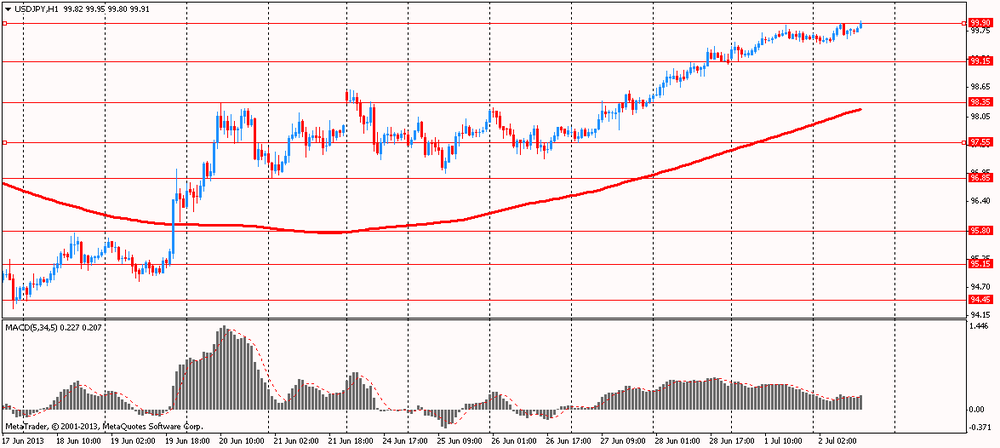Notícias do Mercado
-
19:20
American focus: the euro exchange rate against the dollar has declined markedly
The dollar rose significantly against the euro on data from the euro zone producer prices, which fell for the third month in succession. Producer prices were down 0.1% year on year, after falling 0.2% in April. Economists had forecast that prices will remain unchanged in May. On a monthly measurement of producer prices fell 0.3% in April after falling by 0.6%. But the rate of decline slightly above the consensus forecast of 0.2%.
Investors are waiting for the ECB meeting on Thursday. It is expected that the Central Bank will showcase a soft tone that will increase the downside risks for the pair. It is expected that Draghi will also mark the recent positive reports on the euro zone, indicating that the long-awaited recovery in the 2nd half of the year.
We also add that the dynamics of trading was influenced by the U.S. data. As it became known, the demand for manufactured goods in the U.S. rose in May, which was another sign that the company is stepping up spending after the sluggish winter.
Total production orders to a seasonally adjusted rose in May for $ 9.9 billion, or 2.1%, to $ 485 billion, compared with the previous month, the Commerce Department said Tuesday. Orders have been growing for three of the past four months.
The increase was due to growth in demand in the volatile aircraft sector, but demand for other items, such as computers, also rose, albeit slightly. Factory orders excluding transportation rose in May by 0.6%.
The growth of total orders matched economists' expectations. The report also showed that orders for durable goods - products intended for use longer than three years, such as cars and refrigerators - rose 3.7%, slightly stronger pace, as originally reported. This follows a similar increase in April.
However, a worrying sign was that orders for consumer goods were virtually unchanged, showing an increase of just 0.5% after falling in April and March. However, in a report on Tuesday also shown encouraging trends: companies replenishing their inventories in line with a slightly higher demand. And they're stepping up spending on equipment and software.
The British pound down on expectations the Bank of England, which will hold its first meeting led by M. Carney on Thursday. We also add that the impact of the currency had a statement of the representative of the Bank of England's Tucker, who said that the UK economy seems to be embarking on a path of sustained recovery, but high levels of household debt constrain growth. Recall that the UK economy grew by 0.3% in the first quarter and the British Chamber of Commerce on Tuesday announced its quarterly growth to 0.6% in April-June.
"We are now in a period when it seems that the economic recovery can be sustained," - said Paul Tucker, Deputy Governor of the Bank of England's financial stability. Tucker warned that "the road will be bumpy," referring to the heavy levels of debt in the UK, which hinder growth. "There is a lot of households and firms that have more or less reasonable levels of debt, their debt load is higher than anyone expected - said Tucker legislators. - Due to the household sector is a headwind, which constrains the recovery of demand."
The U.S. dollar rose against the yen, again exceeding the level of 100 Japanese yen for the first time since the beginning of June, as traders become more confident that the Fed will slow the pace of monetary stimulus.
Experts point out that this is an important week for the currency market. Important even today, when in the calendar of economic data are scheduled publications likely to affect the market, except at night catechumen solutions of the Reserve Bank of Australia, but the currencies exhibit significant changes.
Add that investors are slowly buying U.S. dollars on Friday before publication of employment data in the U.S.. It is worth noting that at the end of May month increase in the number of employed in non-agricultural sector exceeded expectations, an increase of 175,000, although the April figures were revised downward. Most companies in the private sector continue to increase the number of their employees, led by the professional sector, a sector of business services, leisure and hospitality industries. We add that the continued decline in employment in manufacturing and the public sector. We also note that, on average, the economy has added just under 190,000 jobs each month this year, although the February reading and overestimated the overall trend. At the same time, adding that the unemployment rate rose 0.1 percentage points to 7.6%, although this was entirely due to rising levels of labor force participation.
According to experts, the decline in unemployment will confirm that the U.S. economy is headed in the right direction and that the Fed is on the way to reduce the amount of asset purchases in September.
-
15:30
Demand for U.S. factory goods rose in May
Demand for U.S. factory goods rose in May, the latest sign that businesses are stepping up spending after a sluggish winter.
Total factory orders rose by $9.9 billion, or 2.1%, to a seasonally adjusted $485 billion in May from the prior month, the Commerce Department reported Tuesday. Orders have risen for three of the past four months.
The increase was driven by a rise in demand in the volatile aircraft segment, but demand for other items, such as computers, also rose, though only modestly. Excluding transportation, orders rose 0.6% in May.
The rise in total orders exceeded economists' expectations of a 2% increase. The report also showed that orders for durable goods--items designed to last longer than three years, such as cars and refrigerators--rose by 3.7%, a slightly stronger pace than initially reported. That followed a similar increase in April.
In one troubling sign, orders of consumer goods were essentially flat, rising just 0.5% after falling in April and March. But Tuesday's report also showed encouraging trends: Companies are restocking their shelves to keep up with slightly higher demand. And they are stepping up spending on equipment and software.
Inventories rose for the sixth consecutive month. Meantime, orders for nondefense capital goods excluding aircraft--a proxy for business investment--rose 1.5%, after rising in April and March.
Factories are having a choppy year, amid a soft economy in the U.S. and woes in Europe and Asia.
A separate report Monday showed that factory activity expanded slightly in June, after contracting in May. The report from the Institute for Supply Management showed growth in new orders, production and inventories. But it also showed that the employment index contracted for the first time since September 2009.
-
15:00
U.S.: Factory Orders , May +2.1% (forecast +2.1%)
-
14:45
Option expiries for today's 1400GMT cut
EUR/USD $1.2985, $1.3000, $1.3050
USD/JPY Y99.50, Y99.60, Y100.00, Y100.20, Y100.50
USD/CHF Chf0.9450, Chf0.9500
AUD/USD $0.9150, $0.9200
-
14:15
Japan labor cash earnings remain flat for second month
Japan's total labor cash earnings stayed unchanged for a second consecutive month in May, preliminary figures from the Labor Ministry showed Tuesday.
Total wages in May amounted to JPY 267,567. Wages have been falling almost steadily since May 2012.
Regular pay declined 0.2 percent from a year earlier in May, while special cash earnings rose 4.5 percent. Contractual cash earnings were down 0.2 percent from last year. Overtime pay slipped 0.1 percent.
-
13:25
European session: the euro fell
08:30 United Kingdom PMI Construction June 50.8 51.3 51.0
09:00 Eurozone Producer Price Index, MoM May -0.6% -0.2% -0.3%
09:00 Eurozone Producer Price Index (YoY) May -0.2% 0.0% -0.1%
09:00 United Kingdom MPC Member Tucker Speaks
09:00 United Kingdom BOE Deputy Governor Andrew Bailey Speaks
The euro fell against the U.S. dollar against the background data on producer prices eurozone, which fell for the third month in succession. Producer prices were down 0.1% year on year, after falling 0.2% in April. Economists had forecast that prices will remain unchanged in May. On a monthly measurement of producer prices fell 0.3% in April after falling by 0.6%. But the rate of decline slightly above the consensus forecast of 0.2%.
Investors are waiting for the ECB meeting on Thursday. It is expected that the Central Bank will showcase a soft tone that will increase the downside risks for the pair. It is expected that Draghi will also mark the recent positive reports on the euro zone, indicating that the long-awaited recovery in the 2nd half of the year.
The British pound down on expectations the Bank of England, which will hold its first meeting led by M. Carney on Thursday.
"The obstacles in the form of cost-saving measures of inflation and recession in the eurozone mean that the Bank of England will have to work hard to support the economic recovery. While we agree with the forecast that the prospects for expanding QE this year declined, Carney can emphasize that the Bank of England is accommodative position. most obvious tool that Carney can use this proactive management, "said Jane Foley, strategist at Rabobank.
Earlier, the pound rose against the dollar after a report showed that activity in the UK construction sector grew in June the second straight month, helped by government initiatives in the housing market. The index of purchasing managers in the construction sector, calculated by Markit and the Chartered Institute of Purchasing & Supply, in June rose to 51.0 against 50.8 in May. As a result of growth in June, the index reached the highest level since May 2012. A reading above 50 indicates an increase in activity, and lower - at its reduction.
The Australian dollar fell against the U.S. dollar after the Reserve Bank of Australia left the door open to lower interest rates in the coming months and said the currency could fall even more. RBA left interest rates unchanged at a record low of 2.75%, but said that the weak inflation gives room for further lowering of the rates if the economy falters.
EUR / USD: during the European session, the pair fell to $ 1.3012
GBP / USD: during the European session, the pair fell to $ 1.5155
USD / JPY: during the European session, the pair rose to Y99.95
In the U.S., will be released at 14:00 Factory Orders for May, and at 20:30 - changes in stocks of crude oil, according to API. End the day at 23:30 Australia data on the index of activity in the service of the AiG in June.
-
11:02
UK construction activity at one-year high
British construction sector activity expanded for a second consecutive month in June and at the strongest pace in over a year, a survey report from Markit Economics and the Chartered Institute of Purchasing & Supply showed Tuesday.
The headline purchasing managers' index rose to 51 in June from 50.8 in May. The June reading was the highest since May 2012.
Readings above 50 indicate expansion of the sector. The index has now remained above 50 for a second successive month in June.
Higher output levels were driven by a solid rate of new order growth in June, and this in turn contributed to rising employment levels in the construction sector during the latest survey period, the report said.
New order growth was the strongest in 13 months. In June, the rate of job creation was the most marked since September 2012. The survey also found that business confidence among builders was at its highest level since April 2012.
Residential building activity improved for a fifth consecutive month, but the rate of expansion eased from May's 26-month high. Business activity stabilized in commercial and civil engineering sub-sectors.
-
10:46
Eurozone producer prices fall for second month
Eurozone producer prices declined for the second consecutive month in May, largely reflecting weak energy prices, data published by Eurostat revealed Tuesday.
Producer prices slipped 0.1 percent on a yearly basis, after falling 0.2 percent in April. This was the second consecutive fall in prices. Economists had forecast prices to remain flat in May.
Month-on-month, producer prices fell 0.3 percent, which was slower than the 0.6 percent decline seen in April. But the rate of decline slightly exceeded the consensus forecast of 0.2 percent.
Prices in total industry excluding the energy sector increased 0.5 percent from a year ago, following a 0.6 percent rise.
Durable consumer goods gained 0.7 percent and non-durable consumer goods rose 2 percent. Likewise, capital goods increased by 0.6 percent, it said.
Meanwhile, prices in the energy sector decreased 1.8 percent and intermediate goods fell by 0.5 percent.
-
10:29
Option expiries for today's 1400GMT cut
EUR/USD $1.2985, $1.3000, $1.3050, $1.3100, $1.3130
USD/JPY Y98.00, Y98.50, Y99.00, Y99.50, Y99.60, Y100.00, Y100.50
USD/CHF Chf0.9450, Chf0.9500
AUD/USD $0.9150, $0.9200, $0.9365
-
10:01
Eurozone: Producer Price Index, MoM , May -0.3% (forecast -0.2%)
-
10:00
Eurozone: Producer Price Index (YoY) , May -0.1% (forecast 0.0%)
-
09:31
United Kingdom: PMI Construction, June 51.0 (forecast 51.3)
-
07:03
Asian session: The dollar was 0.6 percent from the highest level
01:00 Japan Labor Cash Earnings, YoY May +0.3% +0.6% 0.0%
04:30 Australia Announcement of the RBA decision on the discount rate 2.75% 2.75% 2.75%
04:30 Australia RBA Rate Statement
The dollar was 0.6 percent from the highest level in almost a month against the euro as signs of improvement in the U.S. economy buoyed speculation the Federal Reserve will soon start scaling back asset purchases.
The greenback was supported before a report today that may show factory orders gained by the most in three months, and ahead of data this week forecast to indicate a decline in the unemployment rate as companies in the world's biggest economy continued to add jobs. The U.S. Commerce Department will probably say today orders placed with factories climbed 2 percent in May following a 1 percent gain in the previous month, according to the median estimate of economists surveyed by Bloomberg News. If confirmed, that would be the biggest advance since February. Companies in the U.S. added 160,000 workers last month after increasing positions by 135,000 in May, analysts in a separate poll predicted before a report tomorrow by the Roseland, New Jersey-based ADP Research Institute.
New York Fed President William C. Dudley is scheduled to speak on the economy later today in Stamford, Connecticut.
The Australian dollar weakened after an advance yesterday that was the biggest in two weeks before the Reserve Bank announces a policy decision today. RBA Governor Glenn Stevens and his board will probably keep the nation's benchmark interest rate at 2.75 percent at a meeting today, according to 25 of 28 economists polled by Bloomberg. There's a 20 percent chance officials will cut the rate to 2.5 percent, interest-rate swaps data compiled by Bloomberg show.
EUR / USD: during the Asian session the pair traded in the range of $ 1.3050/70
GBP / USD: during the Asian session the pair is trading around $ 1.5200
USD / JPY: during the Asian session the pair traded in the range of Y99.50/75
At 0700GMT, June's Spanish unemployment data is set for release, along with French Jun car registrations. At the same time, EU Economics and Monetary Affairs Commissioner Olli Rehn is slated to speak on the outcome of June's EU Council to European Parliament. ECB Governing Council member Christian Noyer will give a press conference on a report about credit card security, in Paris from 0800GMT. At 0900GMT, EMU May PPI numbers will be published. At 2100GMT, Bundesbank Board member Andreas Dombret speech at a Bundesbank event in New York.
-
06:20
Currencies. Daily history for Jul 1'2013:
(pare/closed(00:00 GMT +02:00)/change, %)
EUR/USD $1,3061 +0,19%
GBP/USD $1,5217 -0,26%
USD/CHF Chf0,9451 +0,01%
USD/JPY Y99,61 +1,18%
EUR/JPY Y130,11 +1,37%
GBP/JPY Y151,57 +0,92%
AUD/USD $0,9233 -0,53%
NZD/USD $0,7820 +0,29%
USD/CAD C$1,0495 +0,19%
-
06:01
Schedule for today, Tuesday, July 2’2013:
01:00 Japan Labor Cash Earnings, YoY May +0.3% +0.6%
04:30 Australia Announcement of the RBA decision on the discount rate 2.75% 2.75%
04:30 Australia RBA Rate Statement
07:00 United Kingdom Halifax house price index June +0.4% +0.4%
07:00 United Kingdom Halifax house price index 3m Y/Y June +2.6% +3.6%
08:30 United Kingdom PMI Construction June 50.8 51.3
09:00 Eurozone Producer Price Index, MoM May -0.6% -0.2%
09:00 Eurozone Producer Price Index (YoY) May -0.2% 0.0%
09:00 United Kingdom MPC Member Tucker Speaks
09:00 United Kingdom BOE Deputy Governor Andrew Bailey Speaks
14:00 U.S. Factory Orders May +1.0% +2.1%
16:30 U.S. FOMC Member Dudley Speak
20:30 U.S. API Crude Oil Inventories June -0.03
21:45 U.S. FOMC Member Jerome Powell Speaks
23:30 Australia AIG Services Index June 40.6
-
05:30
Australia: Announcement of the RBA decision on the discount rate, 2.75% (forecast 2.75%)
-
